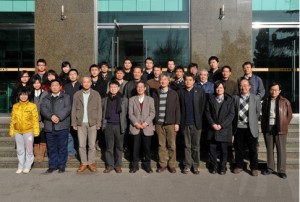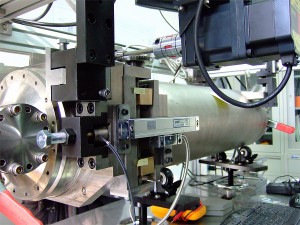
Several physicists from KEK and University of Kyoto visited IHEP in Beijing for the Japan-China Collaboration on SRF Technologies for the ILC. Photo: Jie Liu
Each end-of-year people are used to gathering together to look back on a year of progress and to making plans for the coming year. Experts are no exception, whether from China or Japan. From 7 to 8 December 2010, the IHEP-KEK 1.3-gigahertz superconducting radiofrequency (SRF) technology collaboration meeting was held at the Institute of High Energy Physics (IHEP), Chinese Academy of Sciences in Beijing. This was the third in a series of meetings held regularly since 2009. Eight high-energy accelerator experts from KEK and Kyoto University and nearly thirty researchers from IHEP participated.
“The aims of this meeting are to review the progress of the KEK superconducting radiofrequency test facility (STF) and the IHEP 1.3-GHz superconducting accelerator unit project, to discuss detailed technical problems together with some collaboration agreements for the next few years,” said Jie Gao, chair of the Asian Linear Collider Steering Committee and chair of this meeting. During the meeting, experts from KEK and IHEP gave 16 talks on diverse topics such as KEK-STF status, STF coupler window tests, high-power input couplers, tuner and low-level RF performance and IHEP 1.3-GHz cryomodule and cavity R&D. These talks triggered lively discussion, and scientists achieved some consensus on future cooperation issues.

est setup for an active tuner, built by the IHEP group, which has been attached to a cavity package in use and on lease from KEK. Photo: Nobu Toge
In addition to the first 1.3-GHz low-loss type large-grain nine-cell superconducting cavity (IHEP-01) successfully tested this year, IHEP has started the fabrication of the second cavity IHEP-02, which will be a TESLA-type cavity. It was agreed the second test of IHEP-01 or the first test of IHEP-02 would be performed at KEK, depending on the priority and the schedule. It was also agreed that IHEP would fabricate a TESLA-type cavity as their third cavity. “This will make its test at STF phase 2 easier,” said Kaoru Yokoya, ILC Global Design Effort Regional Director for Asia.
“The year of 2010 was full of progress both for KEK and IHEP: a Japanese cavity recently met ILC specifications at KEK’s SRF test facility and the IHEP-01 cavity achieved an accelerating gradient of 20 megavolts per metre in its first vertical test,” said Yokoya. “The exchange of ideas both from China and Japan creates more opportunities and benefits bilateral cooperation in the future.”
The fourth meeting will be organised between IHEP and KEK ILC groups in 2011 in order to strengthen the IHEP-KEK collaboration. “This meeting series is a good example of ILC Asian collaboration on accelerator technologies. I hope we will have participants from other Asian countries, such as Korea and India, in the future,” Gao said.

Recent Comments